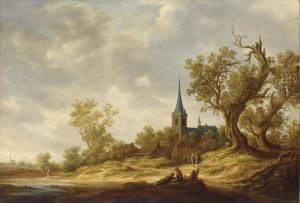Jan I De Vos Paintings
Jan I de Vos was a Flemish painter and manuscript illuminator who lived during the late medieval period, which is often referred to as the Late Gothic or International Gothic period. His exact birthplace is not well documented, but it is believed that he was active in the city of Bruges, which was one of the leading centers for the arts in Europe at the time.
Jan de Vos's work is not very well-documented, and as a result, details about his life and career are sparse. What is known is that he likely came from a family of artists, as the de Vos surname is associated with several painters from the Flemish region during the 15th and 16th centuries. He may have been related to or associated with the more famous de Vos family of painters from the 16th century, which included artists such as Maarten de Vos.
During his career, Jan I de Vos would have contributed to the rich tradition of Flemish painting, which was characterized by intricate detail, vibrant colors, and a high degree of realism. The International Gothic style, to which he belonged, was noted for its elegant and graceful figures, decorative patterns, and often, a rich narrative element in the imagery.
Manuscript illumination was a major art form during de Vos's time, and it involved the decoration of texts with intricate designs, borders, and small painted scenes called miniatures. These illuminations were typically created using rich pigments and often included gold leaf. The works of manuscript illuminators were highly valued and collected by the wealthy and powerful, including members of the Church and the nobility.
Unfortunately, due to the lack of records, none of his works can be definitively attributed to him, and any existing pieces that may have been created by him are either lost or exist under the name of other contemporaries. This lack of attribution is not uncommon for artists of his time, as the concept of individual artistic fame and recognition was not as prevalent as it would become in later centuries.
Jan I de Vos's death in 1430 would have come at a time when the cities of Flanders were transitioning from the medieval period into the early stages of the Renaissance. His work, along with that of his contemporaries, would have set the stage for the later developments in Northern Renaissance art, which would see an even greater emphasis on naturalism and individualism in painting.
